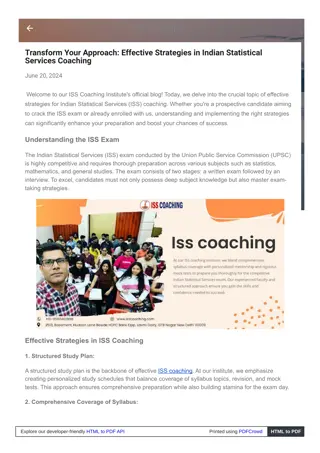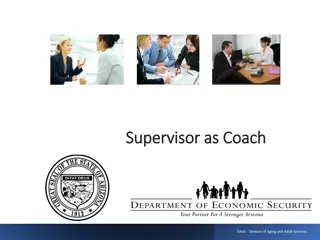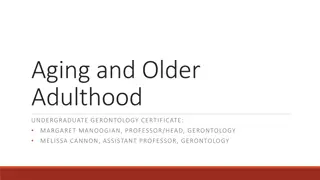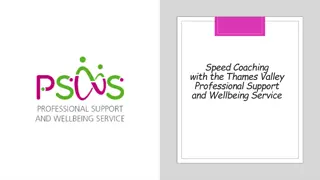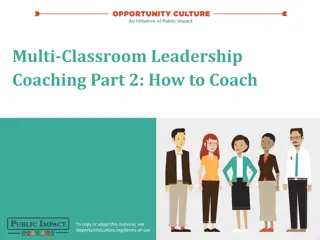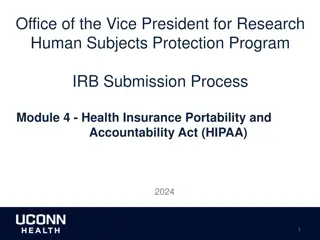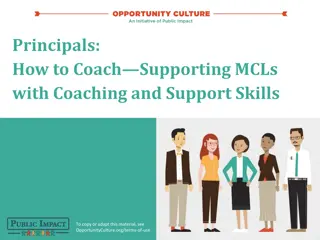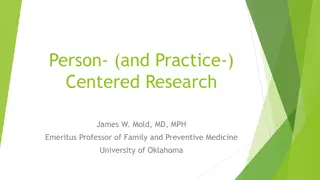PHI's Coaching Approach to Relationship-Centered Care in Gerontology
PHI's Coaching Approach aims to develop universal skills for relationship-centered care, emphasizing active listening, clear communication, self-reflection, collaborative problem-solving, and participative leadership. The Center for Coaching Supervision & Leadership engages in a four-year R&D project to enhance supervisory effectiveness, improve direct-care jobs, and foster better staff relationships across 30 provider sites. The program includes interventions such as executive leader seminars, train-the-trainer sessions, and on-site boosters, with evaluation activities like surveys and focus groups to measure impact.
Download Presentation

Please find below an Image/Link to download the presentation.
The content on the website is provided AS IS for your information and personal use only. It may not be sold, licensed, or shared on other websites without obtaining consent from the author.If you encounter any issues during the download, it is possible that the publisher has removed the file from their server.
You are allowed to download the files provided on this website for personal or commercial use, subject to the condition that they are used lawfully. All files are the property of their respective owners.
The content on the website is provided AS IS for your information and personal use only. It may not be sold, licensed, or shared on other websites without obtaining consent from the author.
E N D
Presentation Transcript
The Coaching Approach to Relationship-Centered Care Gerontological Society of America New Orleans November 2010
PHI South-Bronx Headquarters Three roles: Model development Technical assistance Policy / advocacy State / Federal Strategy
PHIs Coaching ApproachSM A suite of interventions designed to build the universal skills necessary to deliver relationship-centered care driving decision making closer to the consumer and her/his care partners.
PHIsFive Universal Coaching Skills Active Listening Clear Communication w/o Judgment Self Reflection / Self Management Collaborative Problem Solving Participative Leadership
PHIs Center for Coaching Supervision & Leadership Design: Four-Year R&D Demonstration Purpose: Break the cycle of instability Strategy: Prepare nurses/managers to become more effective supervisors Funding: $4.7 Million
PHIs Center for Coaching Supervision & Leadership Intended Outcomes: Improve direct-care jobs Improve supervisory jobs Improve staff relationships 30 Provider Sites: Home care / nursing home Varying levels of intensity
PHIs Center for Coaching Supervision & Leadership Interventions: Executive Leader Seminars Train the Trainer Cross Functional Team Meetings On-site Boosters Peer Gatherings / Executive Leader Summit Technical Assistance / Executive Coaching Coaching Communication Training DCWs
PHIs Center for Coaching Supervision & Leadership Evaluation Activities: Baseline Survey Endline Survey Turnover Data Executive Leader Interviews Trainer Interviews Cross Functional Team Focus Groups Supervisor Focus Groups Direct-Care Worker Focus Groups
PHIs Center for Coaching Supervision & Leadership Nursing Homes: Beth Abraham - New York - 300 CNAs Loretto Fahey - New York - 150 CNAs Medilodge of Howell - Michigan - 150 CNAs Fairview Beth Pike - Pennsylvania - 91 CNAs Sterling - Pennsylvania - 90 CNAs Loomis House - Massachusetts - 52 CNAs Orchard Cove - Massachusetts - 38 CNAs
PHIs Center for Coaching Supervision & Leadership Home Care: Partners in Care - New York - 8400 HHAs/PCAs Partners Boston - Massachusetts - 400 HHAs VNA of Central Jersey - New Jersey - 200 HHAs VNA of Indiana - Pennsylvania - 90 HHAs CH&H - New Hampshire - 82 HHAs/PCAs Keystone - Pennsylvania - 55 HHAs/PCAs
Coaching Supervision uptake: % Reporting Often or Always Practicing Significance & Effect Size (low, medium, high) Before/After Questions Before CS training I held people accountable for doing their job well 63% p < .001 After CS training I hold people accountable for doing their job well Effect Size = .45, medium 88% Before CS training I practiced active listening at work 44% p < .001 Effect Size = .86, high After CS training I practice active listening at work 88% Before CS training I practiced pull back at work 34% p < .001 Effect Size = 1.01, high After CS training I practice pull back at work 82% {Retrospective Questions: n 240}
CCSL Supervision & Job Satisfaction Satisfaction Supervision Scale p = .040* Pre N = 1270 Post N= 1392 p = .004* Pre N = 1298 Post N= 1406 All Staff p = .039* Pre N = 1007 Post N= 1120 p = .003* Pre N = 1038 Post N= 1143 Direct-Care Workers
Increased efficiencies Nurse supervisors and leaders reported their time had been freed to focus on other responsibilities: 25 supervisors reported an average of three hours saved per week following supervision training. As an executive director, I cherish the gift of time. My staff have learned to work together to solve problems at the appropriate level, leaving me the ability to focus on strategic issues ~ Margaret Franckhauser , CEO, CH & H
Residents and clients Coaching with consumers and their families: Coaching promotes a feeling of mutual respect. trying to understand where people are coming from, not making assumptions, applies not just to staff, but also to patients and families. (supervisor) As soon as I said to [a very upset family member] that I wasn t sure what she was asking, so I wasn t sure how to help her, she calmed down (nurse)
One Sites Health Outcomes High Risk Residents with Pressure Ulcers Residents with a Urinary Tract Infection 18% 18% 16% 16% 14% 14% 12% 12% 10% 10% 8% 8% 6% 6% 4% 4% 2% 2% 0% 0% Orchard Cove National Average Trend Line (Orchard Cove) Orchard Cove National Average Trend Line (Orchard Cove)
Organizational transformation Profound change initially individuals, then entire organizations: Coaching Supervision has transformed the culture of this organization. Relationships between our office- based supervisors and home health aides are much more positive even the office is quieter. ~ Marki Flannery, CEO, Partners in Care Coaching Supervision provided the educational foundation for our culture change, which is all about relationships. ~ Paul Hollings, CEO, Orchard Cove
PHIsDistillation Five universal skills Can be learned How to teach How to build capacity (teach teachers) How to sustain
For more information, contact: Steven L. Dawson, President PHI SDawson@PHInational.org




